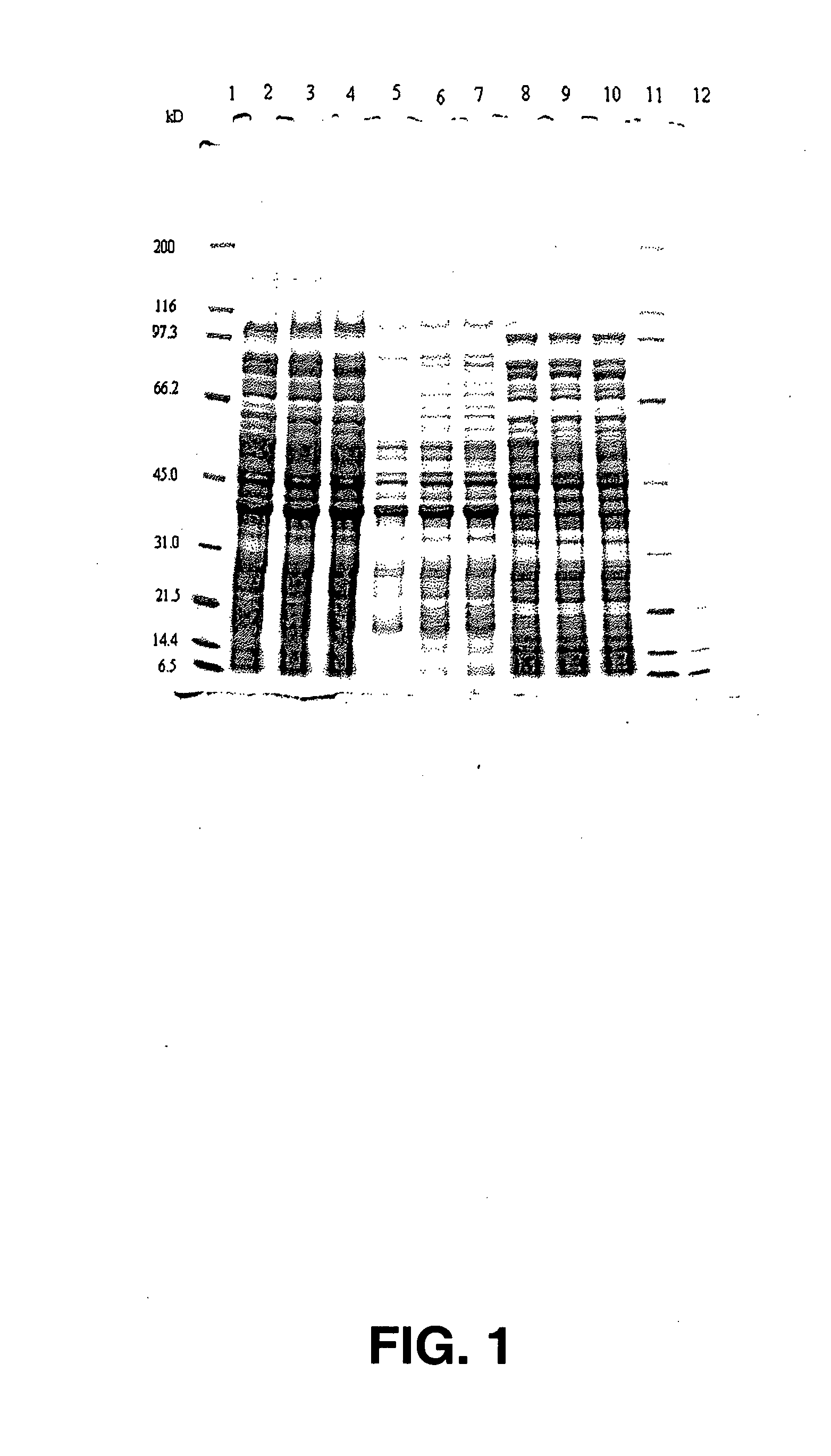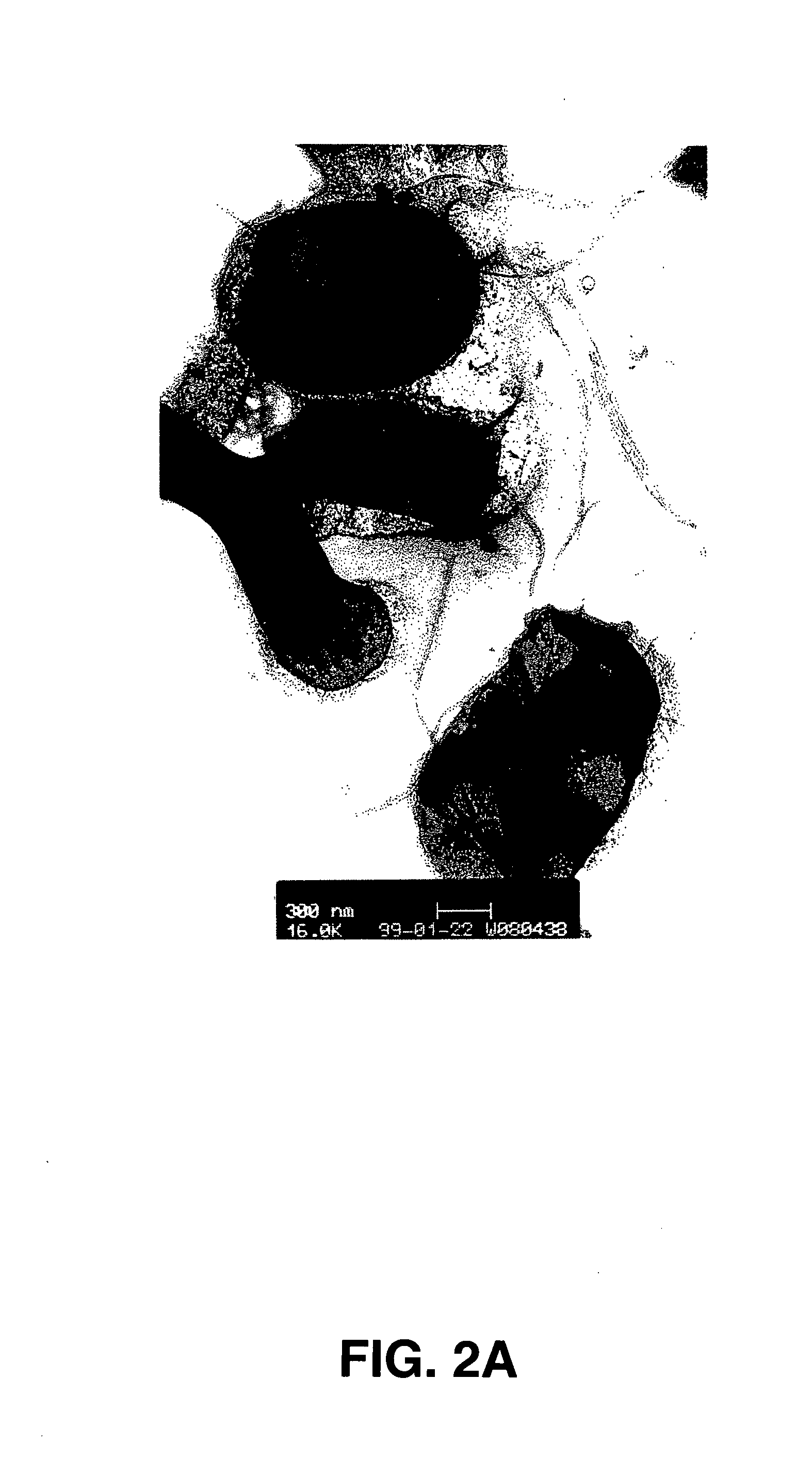Salmonella vaccine
a technology of salmonella bacteria and vaccine, which is applied in the field of salmonella bacteria, can solve the problems of low ability to cope with such infections, difficult control of the source, and practically impossible to avoid infection in the more vulnerable young animals, and achieves the effects of high virulence, high virulence, and low cos
- Summary
- Abstract
- Description
- Claims
- Application Information
AI Technical Summary
Benefits of technology
Problems solved by technology
Method used
Image
Examples
example 1
[0058]Salmonella typhimurium strain STMP, an attenuated strain that has been tested as a live vaccine in poultry and pigs and provides good levels of protection was used as starting material for chemical mutagenesis.
Chemical Mutagenesis
[0059]S. typhimurium STMP was grown on blood agar medium and checked for a positive 0-antigen group B agglutination and H-antigen type 2 agglutination. One colony was inoculated into LB medium and incubated for 20 hours at 37° C. with aeration. Ten μl overnight culture was diluted in 10 ml LB (three cultures) and incubated at 37° C. for six hours with aeration until the culture reached an O.D. at 600 nm of 0.5. A sample was taken to determine the number of viable bacteria. To each of the three 10 ml cultures 100 μl trioxalen (chemical mutagens form Sigma; 3 mg / ml in DMSO) was added and the suspension was poured into a 10 cm Ø petri dish. The suspension was irradiated with U.V. (Transilluminator UVP; wavelength 365 nm) for 5, 10, or 15 minutes at a ...
example 2
Experimental Design
[0066] Vaccines were prepared from a flagellated and a non-flagellated S. enteritidis (“S.e.”) phage type 4 strain. The bacteria were cultured in Tryptose Phosphate Broth, inactivated by the addition of formalin to a final concentration of 0.5%, followed by harvest of the bacterial cells by centrifugation. The cells were resuspended in phosphate buffer saline and formulated into water in oil emulsion vaccines at 5×109 bacteria / ml. Five chickens were injected intramuscularly with the S.e. fla+ vaccine and five chickens received the S.e. flat vaccine. The animals were vaccinated with 0.5 ml vaccine at 14 and 18 weeks of age. At 22 weeks of age, the chickens were bled, and serum was tested in a double antibody sandwich blocking ELISA system specific for antibodies to the g.m flagellin of S.e. (F. G. van Zijderveld et al. (1993) Vet. Quart. 15:135-137).
Animals
[0067] Commercial laying type chickens, approximately 14 weeks of age were obtained from a Salmonella free...
example 3
Experiment 1
Experimental Design
[0069] To assess safety, broilers were inoculated orally (1 ml), subcutaneously (0.5 ml) and intramuscularly (0.5 ml) with flagella-positive Salmonella typhimurium strain STMP, flagella-negative Salmonella typhimurium strain STM2000 or wild-type S. typhimurium (Salmonella typhimurium). The animals were observed for one week after inoculation followed by post-mortem examination of the surviving chickens.
Animals
[0070] Commercial broilers, three weeks of age were obtained from a Salmonella free flock.
Results:
[0071] Following inoculation, eight out of ten animals that had received wild-type Salmonella typhimurium died (Table 1). At necropsy, the two surviving chickens inoculated with the wild-type strain had swollen livers with necrotic foci, swollen spleens and pericardial edema. One of the STMP inoculated chickens had a slightly swollen liver and one chicken inoculated with STM2000 had a slightly swollen spleen. No further abnormalities were note...
PUM
| Property | Measurement | Unit |
|---|---|---|
| Mass | aaaaa | aaaaa |
| Composition | aaaaa | aaaaa |
| Concentration | aaaaa | aaaaa |
Abstract
Description
Claims
Application Information
 Login to View More
Login to View More - R&D
- Intellectual Property
- Life Sciences
- Materials
- Tech Scout
- Unparalleled Data Quality
- Higher Quality Content
- 60% Fewer Hallucinations
Browse by: Latest US Patents, China's latest patents, Technical Efficacy Thesaurus, Application Domain, Technology Topic, Popular Technical Reports.
© 2025 PatSnap. All rights reserved.Legal|Privacy policy|Modern Slavery Act Transparency Statement|Sitemap|About US| Contact US: help@patsnap.com



